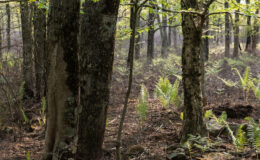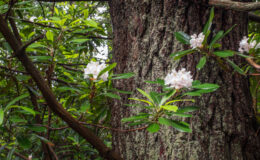One of the joyful moments of spring for me, is when on an early April walk through the woods near my home, I first pick up the trilling of spring peepers, the tiny wood frogs that seem to emerge earlier than their kin, in the Pennsylvania forest. Their existence in our woods depends on a hydrologic phenomenon that occurs with the end of winter.
In the spring, the rains of March and April combine with the water released in snowmelt, to pool in dependent areas in the landscape creating what is a temporary waterway. These ephemeral collections are referred to as vernal ponds. In the northeastern US, these can be found throughout wooded areas, in varying forms; from swampy wetlands, hundreds of yards wide, to the small pools that will form at the base of a root ball, upended by the force of the winter winds, or a summer storm. True vernal ponds last for weeks at a time, or in a wetter year, will last for many months, succumbing finally to the evaporative effects of the warm summer air, and perhaps also to the thirst of the surrounding oaks, maples and hemlocks.
Their importance to the ecosystem is considerable, for they serve as the nursery for the woodlands amphibian species, which will travel over the forest floor for a considerable distance in the cool spring air, to deposit their eggs at a favorite pool.
This is a gamble. If the water dries up before the amphibian tadpoles reach their terrestrial form, then a generation is lost. Hiking, perhaps in late May, I have often come upon the desiccated basin of such a pond, dried up prematurely, the tiny tadpoles mummifying in the chalky mud.
The ephemeral ponds are but one reason that it is important to preserve relatively unbroken areas of forest. Significant disturbances, such as roads, clearings, expose the fragile amphibian populations while en route to lay eggs and breed.







Carol Dombroski
April 6, 2010 8:42 amThank you — I learned something new today. Will be looking at the landscape with a different perspective during our travels.